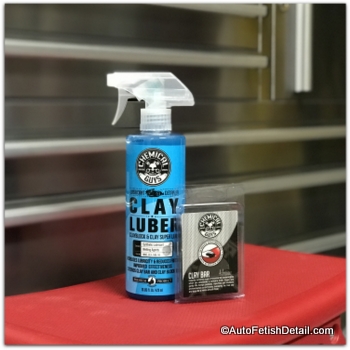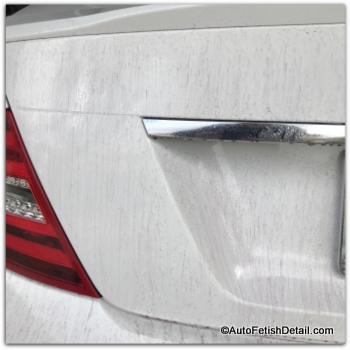Clay Bar Car
The questions not being asked
What are the questions not being asked and what does this have to do with clay bar car? That is the search term you looked up to find this page after all, isn't it?
Maybe. Maybe not.
Regardless of how you found this page, the subject of claying your car is a common subject that may seem simple and basic enough, but quickly becomes a subject far more complex than most people like yourself would think.
Clearly the industry itself doesn't seem very interested in coming clean and educating people like yourself as to the trade-off's associated with using detailing clay to clay bar a car.
And I don't see any other professional detailers or "YouTube Detailers" bent on helping you to become fully informed either.
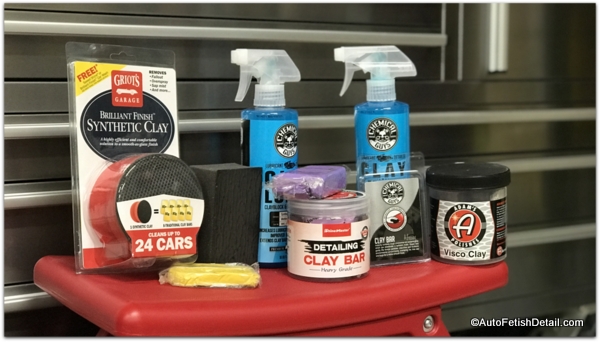
But here you are, and here I am.
You are likely a person looking for the best "tool" to clay bar car, or have recently heard about this tool and came looking for greater understanding and knowledge.
I am a guy with decades of experience and also a guy determined to educate people like yourself to all the pros and cons of any product or tool when it comes to caring for your cars cosmetic car care needs.
Clay Bar Car:
Where to begin....
Despite the fact that this "wonder putty" has existed for decades, I find there are many people who are still unsure as to the unique properties and the amazing abilities of detailing clay when used properly.
But they also don't understand the trade-off's
associated with using detailing clay until they are standing there,
looking at there car in confusion.
While claying your car to decontaminate it is not brain surgery, it is a subject with a lot of bad information and a subject that is instantly complicated since there is no standardization in the industry itself.
The best place to start is what I consider the true starting point of the clay bar: what is the official name of this "stuff". The bad news being that there actually is no official name of this wonder putty.
Not only is there not a standard and accepted "one name" for this stuff, but this stuff (clay bar/detailing clay) comes in different versions or forms.
And this is where we need to start. But before I can start there, I need to lay even further basic understanding in the event you truly are a beginner in the true sense of the term.
Let me reduce this to key points of understanding in bullet-point format:
- In the air, there is this stuff called pollution
- Pollution is made up of very small particles of "dirt"
- The dirt particles that make up air pollution are countless in chemical/particle make-up, originating from an endless sources: basic dust, tail-pipe emissions, rail-dust, factory emissions, paint overspray, tree pollen, bird droppings, minerals from water (hard water deposits) etc., etc., ad infinitum
- All this pollution with all its endless forms of pollutants, will settle onto the surface of your car
- Some of the particles within this pollution that accumulates on your car has the ability to bond to your paint and even etch into your car paint itself
- Traditional car care duties of car washing, waxing, and even polishing your car will not remove the dirt particles that have become bonded and/or etched into your car paint
- To remove these bonded and unwanted particles (called pollutants or contaminates) is the process of decontaminating your car
- Which brings us to the original subject matter of the act of clay bar car
- You need one of the various types of clay bars, decontamination towels, clay sponges, etc. to perform the process of decontamination of your car
Clay Bar Car:
The Art of Decontamination
This is where we need to start. An explanation of why the clay bar or detailing clay has to do with the act of "clay bar car".
In the real world, it is not really about rubbing some weird putty across your car paint, but the process of decontaminating your car paint that is the critical and important step.
Even saying that to a complete beginner would create an automatic level of confusion.
"Darren, why do I need to decontaminate my car? What does that even mean? Is my car infected with some disease or been infected with some strange virus?!"
Trust me; I understand the confusion. Decontaminating and your car doesn't seem like much of a logical match. It simply doesn't compute!
But you don't have to take my word for it. You can confirm this for yourself firsthand on your own car. You can do this easily by simply feeling your car paint. officially there are thee specific ways to determine if your car needs to be decontaminated or clayed:
- Feel it (glide your hand across the paint of your freshly washed car. if you feel any grit or texture, you know you have bonded paint contaminants on your car)
- See it (on lighter colored cars, the bonded contaminants can be seen AFTER you have washed your car and you are visually inspecting your clean car by seeing what appears like dirt specs stuck in/on your car paint)
- Hear it (As you glide your hand across the CLEAN surface of your car paint and glass, you will hear the noise created by the friction of your hand and these bonded paint contaminants)
But if you have made it this far into this page, hopefully you are beginning to connect the dots between the naturally occurring pollution in the air, some of it bonding to your paint, and the need to remove it.
Clay Bar Car:
Mechanical or Chemical
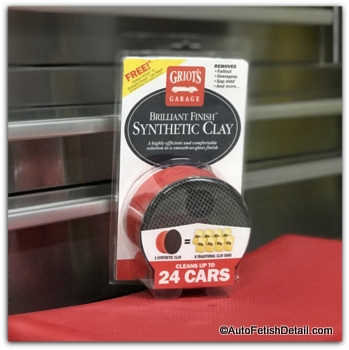
If you are not overwhelmed yet. let me see if I can push you over the edge as most people (including professional detailers) will simply talk about what is officially known as mechanically decontaminating your car paint.
But mechanically decontaminating your car is only one of the ways. It is the most accepted way but depending on who you ask, you may find out about chemically decontaminating your car paint.
Then after all the time you put into reading this page to become a fully informed car owner, you are going to look back and curse me for not informing you completely and more thoroughly.
Which brings us to an additional way of performing some of the decontamination process. And I say "some of" because using a chemical product to decontaminate with will only remove certain types of pollutants that have begun to stick to, and/or etch into your car paint.
Just as using clay bar to clay your car will only remove certain types of pollutants from your car. A more comprehensive and complete way to decontaminate your car is to both use a mechanical form of tool and a chemical product.
Clay Bar Car:
Many names, many types
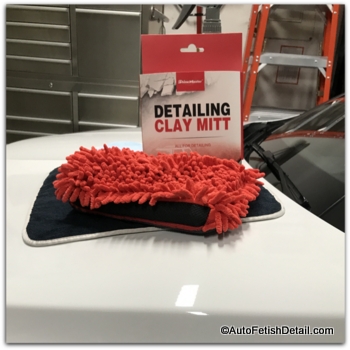
At this point my goal is to bring you to the conclusion that finding the best clay bar is simply part of the means to an end:
Unwanted pollution particles (in their many forms) that get stuck to your cars surface need to be removed, and this process called paint decontamination is simply a way for you to end up with a car that has silky smooth paint, is pollutant free, and is now ready to be either polished and then waxed, or simply waxed.
That is the ultimate goal.
In order to realize this ultimate goal, you will in fact need to find yourself what you (or what I tell you) is the best method, using the best tool to decontaminate your car.
Let me lay out both the various types of decontamination tools, as well as the various ways in which the industry labels the act of paint decontamination.
What we have created within this industry of cosmetic car care is a lack of precision of clarity.
We have the tools (nouns), and we have the process (verbs). And we have an industry filled with lots and lots of people who commingle a noun with a verb.
The task of decontaminating your car (a verb), performed with/by using a tool (a noun), to perform this task of paint decontamination.
|
Different Types of Tools (nouns):
|
Names Used to describe Process (verbs):
|
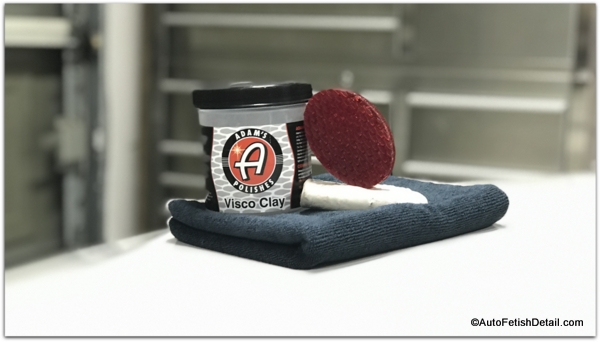
The Clay Bar Process:
Illustration along with the description
The following illustration shows a cut-away of the layers of your car. From the bare body panel (this could be metal, fiberglass, aluminum, plastic, etc.) of the body panel all the way up through the various layers of primer, color coat, to the top coat (also referred to as the clear coat).
The illustration uses various icons to represent the various forms of pollutants that can and do attach to your cars paint and become bonded, or become what I call permanent fixtures to your car paint. At least permanent until you decide to clay bar car to remove these pollutants.
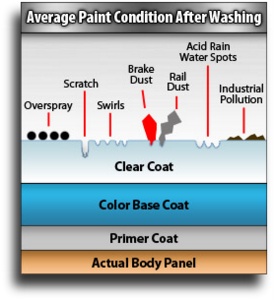
Clay Bar Car:
Mechanical decontamination
Using a clay bar or other form of detailing clay to clay bar your car is a straightforward process. I will lay out the process of mechanically performing paint decontamination using some form of clay bar tool:
- Start with a freshly washed car (we want all the "superficial dirt" off the car)
- Use your choice in a clay lube to wet the section to be worked on (most clay bars come with a dedicated clay lube or a detail spray to be used as a lubricant)
- Clay bars, detailing clay, clay cloths, etc. are all naturally tacky/sticky. This means these tools will automatically stick to your car paint when you lay them on your paint.
- In order to "use" one of these tools to decontaminate your paint, you will have to rub it across your paint surface using back and forth motions to shear away these paint pollutants. (It is this rubbing back and forth that will require you to use some form of lubricant to allow the clay bar to glide across your paint surface)
- At first you will feel resistance and you will "hear" what sounds like scratching. (despite how disturbing this will sound, it is normal)
- You will know when each section is complete as your paint will be silky smooth and you hear no sounds as the clay bar moves across your car paint.
Clay Bar Car:
Chemical decontamination
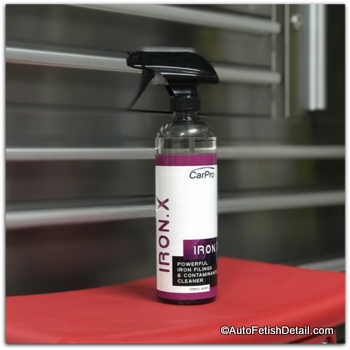
As stated from above, there are both mechanical and chemical ways to perform the decontamination process. You can do one or the other, but if you are a true perfectionist and/or want full decontamination of ALL forms of pollutants, then you will need to perform both mechanical and chemical paint decontamination.
While most companies sell some version of the clay bar to mechanically decontaminate your car, only a handful of campaniles sell chemical products to perform the decontamination process chemically.
These chemical products are formulated chemically to react or neutralize the ferrous (metal in nature) particles/pollutants stuck or embedded into your car paint. Once the chemical product reacts to these ferrous particles, a color change occurs as a result, and typically the product you are using will change to a purple/reddish color.
Choose a product designed to chemically decontaminate your car (see links towards bottom of this page) and follow these generalized steps knowing that you will need to follow the specific steps based on the instructions of the brand you have chosen:
- Spray chemical product on your car to completely cover each section of your car wit product
- Allow product to dwell (most products will change to a color purple/red as the reaction process occurs)
- Most products can be used simultaneously with a form of mechanical decon clay tool: clay bar, clay mitt, clay sponge, etc.
- This means in most cases, you can perform both the mechanical and chemical decontamination of your car
- It also means that you would not need, or likely be advised against using any other type of clay lube since your car will be wet with this chemical product, and your choice of a clay bar will allow you to also rub the clay bar across your paint/glass surface for full decontamination
- Most products will warn against allowing the product to dry on your car before rinsing
- Once each section or entire car is completed, then you rinse or wash your car to fully remove the chemical product and pollutants that have now been "released" from your cars paint and glass surfaces
Darren's Note: While I have not mentioned it specifically, air born pollutants will attach to any surface material of your car. based on the surface material (paint, glass, plastic, chrome, etc) will determine how much of these air born pollutants will stick or embed into these various materials. But the clay bar (or any of the versions) and the chemical products are effective and safe at treating all materials of your car. Just read manufacturers instructions and warnings for verification.
Just know that these air born pollutants do not discriminate and will attach to every surface of your car. You will not just want silky smooth paint, but silky smooth glass as well. Be sure to address all materials on the exterior of your car.
Clay Bar Car:
When enough is enough
As I am infamous for repeating myself within my YouTube videos:
"Nothing is created equally"
Which in this case means that your situation will be truly unique. How much contaminants or unwanted pollutants stuck to your car paint will vary based on many factors:
- How old is your car (and yes; even brand new cars will usually have some level of pollutants on them. And the older your car is, the more time has passed allowing the pollutants to collect onto your car)
- How long do you allow dirt to remain on your car (in simple terms: how long between car washings)
- Overall air quality where you live
- Unwanted, foreign particles on your car come in endless types. So you may have very little traditional types of pollutants, but you may have paint overspray on your car (most people are not even aware this is on their car until they go looking for it. The mechanical process is your first approach to removing paint overspray)
Only in the process of performing the decontamination process will you be able to determine how much effort will be required on your part for full decontamination. And repeated applications may be required for full decontamination based on your standards and expectations for results.
Clay Bar Car:
Asking the right questions
If you follow the lead of the manufacturers of these various clay bar car "tools", you will be informed based on their agenda, but you won't be asking ALL the questions you should be asking.
(With that said, if you have made it this far into this page, you will certainly be asking more of the right questions)
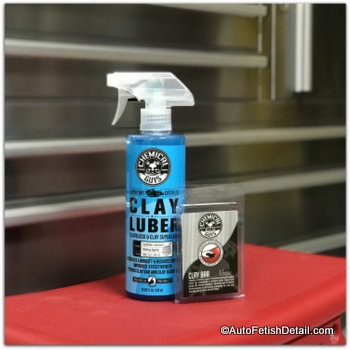
Now that you know the many names these tools go by, and you understand the process of claying a car, the difference betwen mechanical and chemical decontamination, let's discuss the questions most people aren't asking, and unless you know to ask, you aren't going to be fully informed.
Does the Clay Bar Scratch Your paint:
For clarity: I am referring to performing mechanical decontamination using some type of clay bar tool. Yes is the simple answer. But to say that the clay bar scratches your car is a bit of an over-simplification and largely depends on what you would call "scratches". What the clay bar really has the ability to do is really a form of abrading or what we call in the industry as micro-marring. These are very fine abrasions that are put into your car paint as you rub your choice in a clay bar back and forth across your paint.
The more pollutants or contaminants on your car paint, the more you will have to rub. The more rubbing you do, the more micro-marring will happen.
As a side note, your glass/windows will not "scratch" or mar like your car paint will. Also to note, that black plastic trim comes in endless "types" From heavy texture, to smooth. Your ability to rub a clay bar of any type will largely be determined based on the specific black trim. And since it is black trim, and unless it is paint overspray that you can visually see, most people do not concern themselves with pollutants stuck to the black trim or bumpers of their cars/trucks.
Here at this link to AutoGeek.net, they not only do not inform you that using the clay bar can scratch your paint, but actually tell you that it is completely safe when used properly. Of course this is a false statement, and using it "properly" is a subjective call made by them.
If the clay bar scratches your car paint, or at least puts micro-marring into it, why would you want to ever touch your car with any type of clay bar?
Good question. and like I say frequently: everything in life has trade-off's. The trade off here is that if you leave all these air born pollutants attached to your cars surfaces, it will not only affect the user experience of everything you do, but also affects the results of everything you do:
- Washing your car
- Polishing your car
- Waxing your car
- Maintaining your car
having these pollutants stuck to the surfaces of your car means it will affect any and all the products performance, but will also affect the experience in using any of these products to care for your car.
Most people accept that in order to remove these pollutants, that any micro-marring is an acceptable trade-off once they feel and see the finished results of washing, claying, and waxing their car.
Darren's Exception: If you own a dark or black colored car/truck/van and you do use some version of the clay bar to clay bar car, and the contaminants or paint overspray is significant enough, thus requiring lots of rubbing on your car paint, it has the potential to significantly mar the surface of your paint. If this is the case, you will stand back and be frustrated at the appearance of your car paint.
Sure it will be silky smooth, but there may be enough micro-marring that you will be required to perform polishing to remove the micro-marring and restore the shine, depth, and gloss to your paint before you wax your car.
In most cases, o most cars, this micro-marring will be trivial and a heavy-handed application of car wax will be sufficient in creating an end result that most of you will be very pleased with.
If you stand back and determine that you want to take your cars appearance to the next level, then you can polish your car paint with a machine polisher even if you have never held a car polisher in your hands, never mind actually take a car buffer to your car paint.
If this is this case, polish your paint after you have performed the decontamination process and prior to applying any form of car wax or car paint sealant to your car as the final step. Also noteworthy is that you do not have to complete all these steps in a single day. You can do the paint decontamination one day, come back (after dusting off any accumulated dust) and either go into the paint polishing, or car waxing. Break these tasks down into manageable steps so as to not overwhelm yourself to the point of doing nothing!
Clay Bar Car
Summary of questions
Any subject of cosmetic car care or detailing can go from simple to complex in a heart-beat! Clay bar car is no exception. As hard as I try to deliver all critical information so you can make a fully informed decision and be an educated car owner, I will still fail.
Everyone comes to the table within a very broad spectrum of experience and understanding. At best, you will simply have had little to no knowledge at all and I can do my best to educate you. At worst, you will have come with limited information, or even worse, bad information that I must now attempt to correct.
Before I get into my recommendations of he best tools to clay bar car, I will add some additional Q and A in the event I have missed something of significance for you personally:
Let's get you up to speed and work through the myths and confusion that exist around detailing clay that I may not have potentially addressed so far when it comes to clay bar car.
Q - What is a clay bar?
A - A synthetic material very similar in consistency to firm Playdoh. Usually palm size, made by most top manufacturers of car care products.
Q. Why do I need a clay bar?
A. Pollutants of countless kinds floating around in the air your car drives in, and lives in is filled with many types of harmful particles we will call pollutants. Over time, certain amounts of these air born pollutants will bond to your cars exterior surfaces. These pollutants are unwanted and will need to be removed as part of proper cosmetic surface paint care. A clay bar (in its many types of varieties) is one of the ways to remove certain types of pollutants or contaminants.
Q - How do clay bars work?
A - These synthetic bars grab and shear contaminates from the paint/glass (or any hard to semi-hard material of your cars exterior) as it is rubbed back and forth across the paint.
Q - How do I use them?
A - Use the clay bar on a freshly washed paint surface. Used along with a spray lubricant to keep the bar moving freely across the surface. Simply rub back and forth with light/medium pressure until all contaminates have been removed.
Q - What kinds of contaminates will these clay bars remove?
A - Contaminates come in many forms: over-spray from paint, airborne pollution, tail pipe emissions, etc. All of which can be removed when you clay bar car.
Q - Do I have to clay bar car for smooth paint?
A - Yes. Normal washing and waxing will not remove these forms of contaminates from your cars paint.
Q - How often will I have to use these types of surface prep bars?
A - It will be part of an ongoing maintenance plan of proper paint care. Since every situation is different, only you can determine how often is necessary. Whenever you feel any form of surface texture to the paint, the clay bar can be used.
Q - Can you clay bar car too often?
A - This is a question that soon becomes answered once you understand why you clay your car initially, and once you have actually clayed your car. Unlike waxing your car, claying your car is simply a way to remove paint contaminants. You get no visual pay-off for performing this requirement like you do when you wax your car and it looks way better! So the compulsion to clay your car when it doesn't actually need it pretty much never exists. And for this reason, once a person actually does take the time to clay their car, they will do it as little as possible. The very first time you clay bar car, it will definitely take longer than any follow up maintenance claying.
Q - I have a new car, is it necessary for me to clay bar car?
A - Probably. Only you can determine this for sure by feeling the surface of the car paint after it has been washed. Most cars will be exposed to the elements of pollution from the moment they are taken from the manufacturing plants, down until they reach the end user. Your particular car may sit on a dealer lot for months and months. So just because your car is brand new, does not eliminate it automatically from having to be decontaminated as a new car. I have yet to meet a brand new car that didn't need it!
Q - How much time can I expect when using the clay bar for the first time?
A - Depends on how much "pollution" is in/on your paint. I have spent as much as (2) hours removing these bonded pollutants from a car on an older car that had accumulated excessive amounts of "pollution" that had never been "clayed" before, to as little as ten minutes to remove very light amounts which is more common on any newer car. When it comes to regular maintenance and you use detailing clay every few months, the process might take you just a few minutes to clay your car.
Q - Will the clay bar scratch my car paint?
A - Short answer is yes. Long answer is this: all depends on what you consider scratching. The more appropriate term would be micro-marring or abrading. Marring or abrading and scratching are really two different things. Using the clay bar will indeed put very superficial micro-marring in the paint. The heavier the build-up of pollutants, the more marring will be done.
Q - If the clay bar scratches or abrades the paint, then why would anyone be willing to or want to clay bar their car?
A - Most choices in life come to trade-off's. We are constantly forced to pick what we call the winning combination which usually consists of more benefits than drawbacks. Having texture to your car paint is considered unacceptable to most people, and in order to remove this pollution from your car's paint, the clay bar is the most straightforward option to remove most paint surface contaminants. And the type of scratching or abrading that will be done in the process will generally be very superficial and will be polished away in most cases by simply applying a coat of wax either by hand or a polisher.
Q - If the clay bar really scratches or abrades your car paint, why would the manufacturers not warn against this on their labeling.
A - There used to warning labels back in the day when clay bars were first introduced. Because the detailing clay has become so acceptable and the results are so welcomed, we have learned to look the other way and not talk about this fact. Additionally, clay bars were originally only available at a professional level, and it was acknowledged that if you were to use the clay bar, you would typically have to follow up by polishing the car. Of course once again, most cars don't require the use of aggressive use of the clay bar and therefore the abrading that takes place is so minimal that most people would not even have a trained eye in which to see this type of abrading.
Clay Bar Car:
Mechanical Clay Bar Kits and Tools
I could overwhelm you with literally hundreds of clay bars and clay bar kits. But in the name of geting you closer to your end game of silky smooth, contaminate free car paint, I am limited my recommendations to a few options in the form of the different types of decontaminating tools.
I am going to include both mechanical and chemical versions of products if you are the dedicated type and really want maximum results in the paint decontamination process. :
Mothers Clay Bar Kit
Mothers 07240 California Gold Clay Bar System
- The most popular kit on Amazon
- I have used and tested myself (thumbs up for this kit)
- Comes with (2) clay bars and clay lube (the clay lube is their instant detailer)
- I love kits: save time and money by not having to source the individual components separately
Nanoskin Auto Scrub
Nanoskin AUTOSCRUB Fine Grade Wash Mitt [AS-016]
- These clay bar alternatives come in the form of a wash cloth: one side is micro-fiber cloth, the other side is a rubberized, synthetic rubber that performs like the traditional clay bars
- Use these just like you would a clay bar: rub your paint while using some form of a lubricant
- The biggest selling point of these clay bar alternatives are the ability to wash away the paint contaminants from the cloth, and how perfectly they conform to the body lines of your car (when using a traditional clay bar, you don't wash away the contaminants as they come off your car, the contaminants simply collect into the clay and you knead the clay bar as you use it to reveal a cleaner section)
- The draw back of these cloths is that if the rubberized side comes in contact with itself (as if the cloth gets folded onto itself) it is very difficult to pull apart; especially in warmer temperatures
- I have used these and many people find the user experience much better with these cloths than that of a traditional clay bar
Griot's Garage Synthetic Clay
Griot's Garage 10691 Synthetic Clay (Brilliant Finish)
- Uses same synthetic rubberized material as other clay bar alternatives, but configured in the user friendly and economical sponge
- Use with your choice as a clay lube by rubbing back and forth across your paint
- Excellent user experience
Adam's Clay Mitt
Adam's Premium Clay Bar Mitt - Medium Grade Clay Material - Easy Car Detailing Clay Bar Alternative Quickly Removes Bonded Contamination to Your Paint, Glass, Wheels and More
- Same synthetic rubberized material configured into a handy to use mitt
- Open ended so your hand can slide into this version and then use like a hand mitt
- Use with your choice in a clay lube
- Great user experience
Clay Bar Car:
Chemical Iron Removers
If you have been paying attention, you will know at this point that to perform complete and thorough paint decontamination when you clay bar car, you will also need to use one of the chemical products offered by a few of the manufacturers.
These are labeled with different terms and just like the clay bar, there is no standardization in this industry.
CarPro Iron X
CarPro Iron X Iron Remover 500 ml with Sprayer
- Use to chemically decontaminate your car
- Reacts to ferrous (metal) contaminates on your car (paint, glass, chrome, wheels, all car components and surfaces, etc.)
- Only reacts to ferrous pollutants; does not remove other forms of bonded contaminants
- Turns a purple on your car as it dwells and chemically reacts to these ferrous particles
- Rather fowl smelling (this is normal and part of the experience and trade-off for eliminating the ferrous particles on your car)
- Works on your car wheels also (your brake pads throw metal particles whenever you use your brakes. These particles are part of what settles onto your paint that these chemical products chemically react to. For this reason your car wheels will also have plenty of these ferrous particles on them and these products make good wheel cleaners)
GYEON Quartz Iron Remover
GYEON Quartz Q²M Iron 1000 ml - Iron Remover Breaks Down Embedded Iron Deposits in Paint and Wheels
- Use to chemically decontaminate your car paint
- Just like any of the other chemical products I recommend on this page, this works in the same manner and has the same uses as the others (decontaminate paint, glass, wheels)
- Also has a rather fowl smell to it when using
Clay Bar Car Summary
By this point you can consider yourself as an expert on the subject of clay bars, clay bar car, and alternatives to the traditional clay bar. You will now know more than most professional detailers I come across in my travels.
I wish you much success in clay bar car efforts!
Sincerely,
Darren Priest
- Home
- Detail Clay
- Clay Bar Car
|
|
